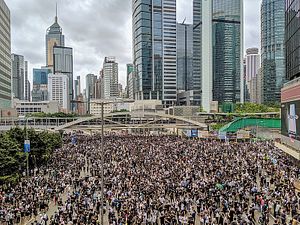The city of Hong Kong is no stranger to protest. Citizens turn out annually to commemorate the crackdown on June 4, 1989, in Beijing’s Tiananmen Square and the July 1, 1997, handover from U.K. to Chinese rule. In the fall of 2014, a new movement dubbed the Umbrella Movement (also referred to as the Occupy Movement) took shape as sit-ins and protests were held over the course of many weeks to resist a Beijing-back proposal to reform the city’s electoral system. The protest movement also gave rise to a handful of new political parties that have sought to push back harder against more conservative and pro-Beijing power bases in Hong Kong.
Against this backdrop, this summer’s latest wave of demonstrations may not seem so out of the norm. However, the tone of this summer’s protests suggests an escalation in urgency from those angry with both the Hong Kong government and greater influence from Beijing in the special administrative region. This summer’s discontent was initially sparked by opposition to the Hong Kong government’s proposed amendment to the city’s extradition laws. While early signs of resistance date back to March, the months of June and July have seen a steady intensification, both by protesters and authorities. Though the bill has been sidelined, political tensions are still simmering as the movement has shifted to focus on broader and deep-seated issues.
Much like the Umbrella Movement, many of the protesters are young peoples in their teens and 20s who have expressed a lack of trust in leaders and hopelessness about Hong Kong’s political future. A small number of suicides, reportedly linked to the protest movement, have since become fixtures in protest art, and as such have in some instances been held as martyrs for the cause.
Protesters, who are by and large peaceful, occasionally ramped up their actions, including charging police, storming and defacing the city’s parliamentary building, and vandalizing the Beijing liaison office. As clashes have turned violent, authorities have employed tear gas, pepper spray, sponge grenades, and rubber bullets to disperse crowds. Separately, a pro-police mob targeted protesters in a metro station in Hong Kong’s New Territories in late July, beating them with umbrellas. Pro-democracy supporters complained that police failed to respond and alleged that the attackers were hired hands from Hong Kong’s organized crime. Moreover, police prohibited an anti-mob violence march planned for this weekend.
The tension between Hong Kong and mainland China has not been solely confined to the city. In June, dozens of cities around the world, including in the United States and across Europe, held rallies in solidarity to demand the withdrawal of the extradition bill. Although the U.S. State Department has said that attacks on bystanders and protesters by gangs were “particularly disturbing,” U.S. President Donald Trump has also praised Xi Jinping’s handling of the recent spate of protests, arguing that while “China could stop them if they wanted,” China’s leadership has acted responsibly.
Taiwan has extended support not only by backing the protests themselves, but also by allegedly extending assistance to Hong Kong activists who arrived on the island fearing prosecution by local authorities as protests have grown more aggressive. This month, #PrayforHongKong was trending in the Philippines as netizens voiced support for protesters. Elsewhere, scuffles between students from Hong Kong and China broke out earlier this week at Australia’s University of Queensland in Brisbane, with some chanting “free Hong Kong” and carrying signs about Xinjiang detentions while others played the Chinese national anthem and tore up signs.
Beijing’s response has been stern, condemning the protesters as rioters and insinuating that they are supported and influenced by “foreign forces.” Though management of the protests has fallen largely to the local authorities, it was recently reported that a People’s Liberation Army group carried out training exercises to curb large-scale unrest and restore order only a few hundred kilometers from the financial hub.
Hong Kong authorities have stated they will not seek Chinese military assistance to subdue protests, but Beijing is pulling no punches in its use of tough rhetoric, likely to highlight and demonstrate a position of strength vis-a-vis the protesters. Moreover, this week, China’s foreign ministry spokeswoman Hua Chunying said, “The PLA in Hong Kong has been a pillar for the city’s long-term prosperity and stability,” hinting at Beijing’s importance and power over the city’s future development as well as its primary interest in maintaining territorial stability. While the prospect of a PLA intervention remains unlikely for now, the reminder of such a possibility has also yet to prove particularly effective in thwarting further protests.

































